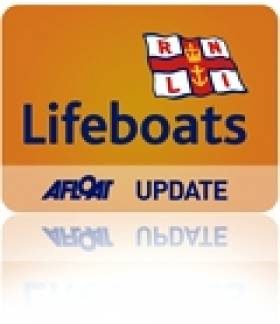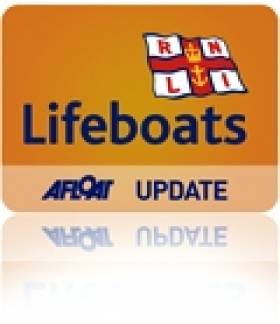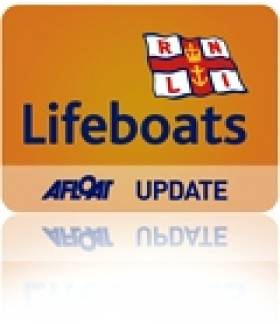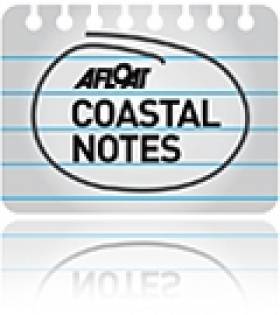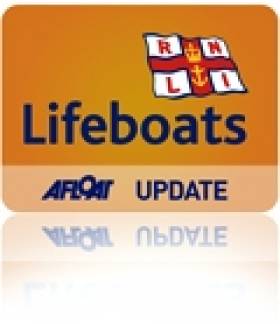Displaying items by tag: Skerries
Skerries Lifeboat Crew Rescue Dog Stranded On Rocks
#RNLI - Following the dramatic rescue of a dog who fell from sea cliffs on Howth Head at the weekend comes news from Skerries of another pooch stranded off the shore by high tide yesterday afternoon (Tuesday 12 January).
Mollie, a border collie cross, had been missing since the previous evening after becoming frightened and running away. She was finally spotted yesterday morning in the Red Island area in Skerries.
However by the time her owners had located her, she had made her way onto the rocks behind the lifeboat station and had been cut off by the rising tide.
At the time, a combination of the location and conditions meant that launching the lifeboat and attempting a rescue from the sea was not an option.
But Skerries RNLI volunteer lifeboat crew David Knight and AJ Hughes were able to wade safely out to the rocks from the shoreline wearing their personal protection equipment and using a safety line.
Once recovered, Mollie was handed over to her grateful owners at the shoreline who took her straight to the vet for a full check-up.
Christmas Shop To Raise Funds For Skerries RNLI
#RNLI - Skerries RNLI's Christmas shop opened for business this past Sunday 15 November and will be open again every Sunday until Christmas from 11am to 1pm.
The North Co Dublin lifeboat station will also once again be holding a Christmas raffle with tickets available at the shop.
This year the prizes for the raffle are two beautiful paintings which have been generously donated by the extremely popular local artist Dave West. Tickets for the raffle are €2 each or 3 for €5.
There is also a large selection of items available in the shop again this year. From torches to teddy bears, buckets to books, cards to calendars, there really is something for everyone. And with many of the items costing less than €2, there are also some great ideas for stocking fillers.
Speaking about the raffle, volunteer lifeboat press officer Gerry Canning said: "We are very grateful to Dave West for supporting the local lifeboat through these prizes. This is a great opportunity for someone to win a painting by a very popular artist and would make a great Christmas present."
Donaghadee Lifeboat In Search For Stranded Dog
#RNLI - RNLI volunteers aboard Donaghadee’s all-weather lifeboat Saxon launched on Tuesday night (29 September) to search for a family’s pet dog which was reported to have been cut off by the tide at Millisle on the Ards Peninsula.
Coxswain Philip McNamara and his crew took the decision to launch after a request from Belfast Coastguard at 9.30pm and were on the water within 10 minutes.
When they reached the area, the crew launched a smaller inflatable craft, designed for inshore work, and conducted a search of the shoreline in darkness.
"We could find no trace of the dog and hope that it reached safety," said McNamara. "There is always the possibility that someone will enter the water to save a family pet and that means there is a risk of them drowning. The RNLI is here to save lives at sea no matter what the circumstances might be."
The launch came just a day after the Donaghadee crew spent eight hours afloat as part of a major search operation for a missing kayaker, as previously reported on Afloat.ie.
Elsewhere, Skerries RNLI towed a fishing boat with four men on board to safety on Sunday (27 September) after a passing yacht alerted the lifeboat that the vessel was in difficulty.
While out on routine Sunday morning training some two miles northeast of Skerries, helm Eoin Grimes and crew members Peter Kennedy and AJ Hughes were called into action after learning from the skipper of a passing yacht that a fishing boat nearby had suffered engine failure.
The fishing vessel, which had four men on board, was taken under tow by the lifeboat and towed to the safety of Balbriggan Harbour, where they had set out from. Conditions at the time were calm with a Force 1 to 2 southerly wind.
Speaking after the callout, Skerries RNLI volunteer lifeboat press officer Gerry Canning said: "We would urge anyone going to sea to ensure that have adequate safety equipment on board and a means of contacting the shore should they experience any difficulty."
Skerries RNLI Respond To Submerged Car On Gormanston Beach
#RNLI - Skerries RNLI responded to reports of a car submerged on Gormanston beach yesterday afternoon (17 September) following an emergency call to the coastguard.
Shortly before 2.30pm, Skerries RNLI were tasked by Dublin Coast Guard to investigate a submerged car on Gormanston beach after they received a 999 call from a concerned member of the public.
The lifeboat – with Joe May at the Helm and crewed by AJ Hughes, Laura Boylan and Ian Guildea – launched and made their way directly to Gormanston Beach. Conditions at the time were relatively calm with Force 3 westerly winds.
After arriving on scene, the crew located the car and were able to confirm that it was unoccupied.
As a precaution, Irish Coast Guard helicopter Rescue 116 carried out a sweeping search of the coastline while the lifeboat carried out a search of the immediate area. Skerries Coast Guard unit also conducted a search of the shoreline.
Nothing was found and Gardaí later confirmed that the car had been reported as abandoned.
Speaking after the callout, Skerries RNLI lifeboat press officer Gerry Canning said: "This was a positive outcome as it turned out nobody was in danger. The member of the public did the right thing by dialling 999 and asking for the coastguard."
#RNLI - Skerries RNLI volunteers launched for their third callout within seven days yesterday (Saturday 04 July) following reports of a kayaker in distress off Gormanston beach.
The pagers sounded shortly after 11.30am this morning, with the lifeboat – launched with volunteer Joe May at the helm and crewed by volunteers Emma Wilson and Paddy Dillon – proceeding directly to Gormanston.
Once on scene it was established that the casualty had abandoned his vessel and his belongings and swam to shore. The crew located an inflatable kayak nearby and recovered it onto the boat to prevent any hazard to other vessels. Conditions at the time were fair with a Force 3-4 northerly wind.
On the previous Thursday evening (2 July), while on a scheduled training exercise, Skerries RNLI were tasked by Dublin Coast Guard to investigate reports of a personal water craft in difficulty near Colt Island in Skerries.
The lifeboat was on scene very quickly as they were on exercise in the area. They located the casualty and took him on board the lifeboat, towing his vessel to the safety of Skerries Harbour. After a routine assessment he was deemed to require no further assistance.
Four days before that, Skerries RNLI brought four people to safety after their racing yacht was holed when they struck rocks near Colt Island, as previously reported on Afloat.ie.
#RNLI - Skerries RNLI brought four people to safety on Sunday afternoon (28 June) after their racing yacht began taking on water after striking rocks near one of the islands off Skerries.
Volunteers launched their Atlantic 85 inshore lifeboat Louis Simson shortly after 4pm when reports were received by Dublin Coast Guard that a yacht had struck rocks near Colt Island.
The lifeboat, with Philip Ferguson at the helm and crewed by Eoin Grimes, Simon Shiels and Emma Wilson, made its way directly to the area reported, where the casualty vessel was quickly located.
Having freed themselves from the rocks, the yacht and its crew were making their way towards Skerries Harbour, though water was leaking into the yacht through damage to the hull.
The lifeboat was positioned alongside and a crew member boarded, bringing the salvage pump carried aboard the lifeboat.The yacht was then taken under tow and brought to the safety of Skerries Harbour, where several more volunteer crew joined the others and assisted in getting the yacht on to a trailer and taken out of the water.
Speaking after the callout, Skerries RNLI volunteer lifeboat press officer Gerry Canning said: "The RNLI spends a lot of time and effort making sure that our volunteers have exactly the equipment they need to cater for any kind of emergency.
"In emergencies such as this, the salvage pump can be invaluable."
Skerries Boat Beats 1800 Others To Win Round The Island Race
#rtir – It's not the first time that Italian marine technical ace Giovanni Belgrano (he was the nuts-and-bolts man on the Italian America's Cup challenges) has surprised the fleets of modern boats on his adopted home waters of the Solent with an ace performance with his exquisitely-restored 1939 Laurent Giles 39ft centreboard sloop Whooper.
Nevertheless his overall win in Saturday's Round the Island Race was a sweet victory to be savoured with joy. Even more so, writes W M Nixon, when you realise it was all done with a boat from Skerries, County Dublin....
Yes indeed, folks. Through the 1960s and the early 1970s, Whooper was based in Skerries under the ownership of the great Christy Fox and his son Joe.
And here's the Lloyds entry from the register of 1970 to prove it:

Lloyds Register of 1970, with Whooper at home in Skerries
They'd chosen this unusual boat because her centreboard configuration gave them the shallow draft needed to be able to berth her alongside Skerries pier, rather than having to keep her in that dreadful anchorage out in the open bay. Having been built by Woodnutt's, she was a quality job, full of character, and well able to give a reasonable account of her herself in local races when they were able to get enough of a crew together to make the best of her.
In time she was sold away. But then a couple of years ago the Classic Yacht Regattas in the Solent area started featuring a beautifully-restored Whooper scoring serious wins. It speaks volumes for her owner's joy in sailing that he's at the sharp end of technological development around advanced boats in the day job, yet in his spare time he goes sailing in a very interesting old boat on which he has clearly lavished much loving attention.

Whooper's hull profile showing how the centreplate was incorporated into the hull without undue intrusion on the accommodation. In that same accommodation, many a boisterous party was held alongside Skerries pier, and in other ports too.
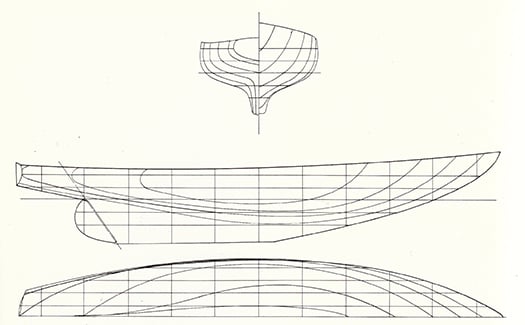
Whooper's hull lines. She was conceived as a comfortable shoal draft cruise to provide reasonably good performance, but no-one could have imagined that 77 years after she was designed, she'd be overall winner of the Round the Island Race.
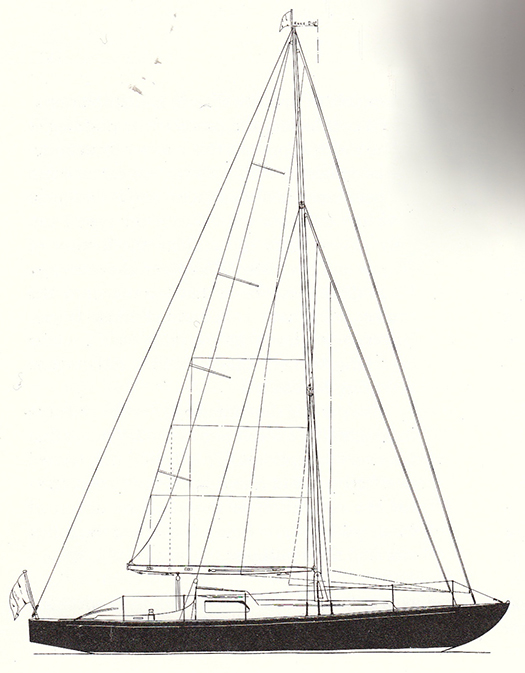
Whooper's rig was an early version of the Laurent Giles "slutter". which could be both fractional and masthead, though during her time in Skerries she was always sailed as a masthead sloop. She also had one of the earliest Laurent Giles' versions of the new-fangled doghouse to give added headroom and better light in the aft part of the saloon.
In all, there were something like 14 boat with Irish links in the 1800-strong fleet which raced round the island, and it seems that the best-placed was Ben Daly's Quarter Tonner Cobh Pirate in 202nd place. That is, of course, if we don't just reclaim Whooper as one of our own.....
Skerries Lifeboat Saves Man From Drowning
#RNLI - Skerries RNLI saved a man from drowning yesterday afternoon (Wednesday 22 April) as they responded to an emergency call on their pagers.
Volunteer crew member Stephen Crowley was giving one of his fellow volunteers, helm David Knight, a lift ashore from his own boat shortly after 5pm when the pagers were set off.
As they made their way to the slipway at the back of the harbour to get to the lifeboat station, they encountered a man in the water who had become separated from his personal watercraft and was struggling to stay afloat.
They managed to get a rope around the man and help him onto the side of their boat and began bringing the man to shore, where they were joined by two more volunteers, helm Philip Ferguson and crew member Emma Wilson, who were already fully suited up and preparing the boat for launch when they saw the situation unfolding from the lifeboat station.
The man was helped ashore and was assessed for any first aid requirement.
Speaking after the callout, volunteer lifeboat press officer Gerry Canning said: "Fortunately our volunteers were on hand almost instantly. It is important to remember that whatever your activity, wearing a well-fitted and suitable lifejacket or buoyancy aid could save your life."
Skerries Named Among 'Most Beautiful Cities In Europe'
#CoastalNotes - TheJournal.ie might not take the news entirely seriously, but it's true – Skerries has been named among the 10 most beautiful cities in Europe.
The North Co Dublin coastal town and fishing port might only have a population of 10,000, but Eating Europe Food Tours saw fit to include it alongside perennial continental favourites such as Amsterdam and Barcelona.
And TheJournal.ie has collected a few images that show exactly why Skerries is a jewel to be treasured, even if it isn't really a city!
First Callout Of 2015 For Skerries Lifeboat
#RNLI - Skerries RNLI was requested for the first time in 2015 yesterday morning (Thursday 8 January) following a report of a swimmer in difficulty.
The volunteer crew launched their Atlantic 85 lifeboat Louis Simson at 11.30am following a call to Dublin Coast Guard from a concerned member of the public about a swimmer in the water off Red Island headland.
The lifeboat, with Joe May at the helm and crewed by David Knight, AJ Hughes and Stephen Crowley, launched and proceeded directly to the area indicated by the coastguard.
Arriving on scene, it was discovered there was a local swimming group ashore after returning from a swim. After speaking to the group, the volunteer crew were assured that everyone was accounted for.
The lifeboat performed a precautionary sweep of the area before being stood down and returning to station.
The Irish Coast Guard helicopter Rescue 116 was also on scene and carried out a search before returning to base.
Speaking after the callout, Gerry Canning, volunteer lifeboat press officer for Skerries RNLI, said: "Thankfully in this case our assistance wasn’t required.
"However, the member of public had good intentions and we would always advise people to dial 999 and ask for the coastguard if they think they see someone in difficulty at sea."




























